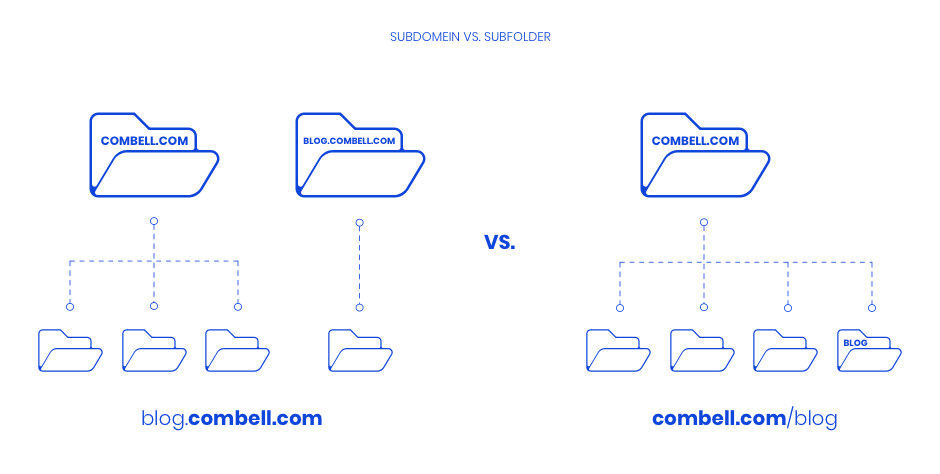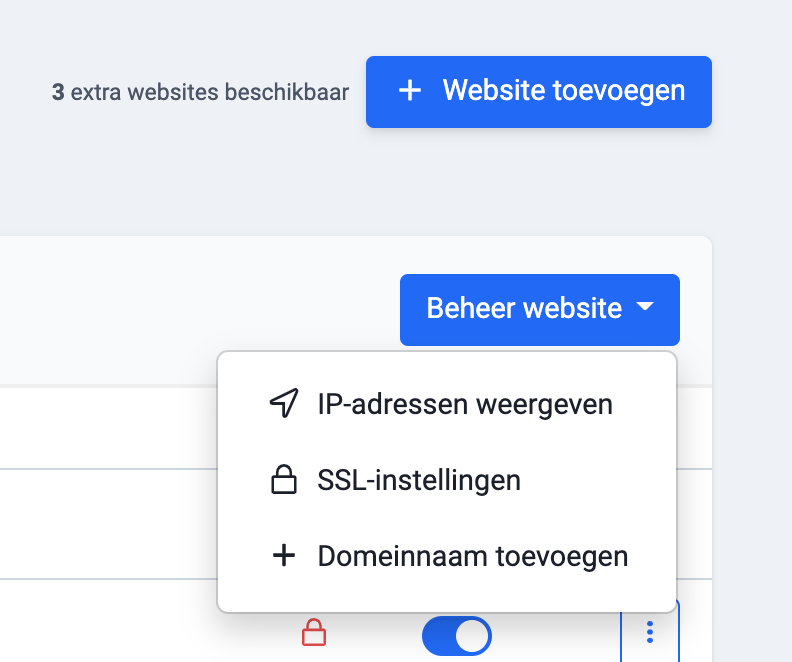A subdomain is an extension of your domain name. Chances are that you have already dealt with subdomains without knowing it. We would like to make sure that next time you see a subdomain, you will know what it is, what you should use it for, and how to create one.
What is a subdomain?
A subdomain is a part of your domain name. Subdomains are often used by larger companies to link a ‘new’ website to an existing one. That may still sound like gibberish to you, but we are here to help you understand it all ☺️!
Let us first examine a domain name (or ‘domain’):

blog.combell.com
- .com – top-level domain
- .combell – second-level domain
- blog – subdomain
A top-level domain is your extension, a second-level domain is the main name of your website, and a subdomain is an extension of your domain name.
In principle, you could add even more levels to your domain name, like this: look.here.this.is.my.blog.domain.com. But to be honest, that is more of a joke, as it is not really useful.
However, it is advisable to keep an eye on the address you are visiting. Because there are people – or let us call them what they are: ‘idiots’ – who set up the name of a website as a subdomain of their own, in order to trick you and get hold of your data. This practice is called ‘phishing’.
Example:
A fraudster has set out to scam Combell customers by using their own website, phishingsite.be. They achieves this by sending fake e-mails on behalf of Combell, with a link that looks like this: my.combell.com.phishingsite.be. The recipient of the e-mail sees combell.com in the address and thus trusts the link and enters their personal details on the site, which is actually a part of phishingsite.be. This is how the recipient falls victim to this phishing attack.
It is therefore very important to read a web address from right to left. This will help you make sure you are on the right website!
Examples of subdomains
A subdomain can have any name. Here are a few examples:
- m.facebook.com
- mail.google.com
- my.combell.com
- myblog.wordpress.com
That company is so big that it has become a necessity to divide everything into convenient subdomains. Below, you can see some (not all) of them!

What should you use a subdomain for?
Order
A subdomain is used to divide your website into different parts. Dividing your website into subdomains for your blog, your web store, your customer service or any other purpose makes it much clearer. Because each part of your website has its own place with a clear name.
Example:
Frank sells furniture. His website is called furniturefrank.com, and he has recently launched a web store. That web store can be reached very easily via shop.furniturefrank.com. So, anyone who wants to buy furniture from Frank can go there right away.
Another example could be a company that wants to run a marketing campaign with a look and feel that is different from that of its main website. For this, the company uses a subdomain, like this: campaign.domainname.be. This ensures that the main website does not become a weird mishmash of different styles.
Target audience
When you visit a website, your browser already provides certain information to that website. This information may include your location, the language of your browser or the type of device you are using.
This makes it possible for a website to decide which page is best for a visitor, based on, for example, language or location. Two different visitors of the same website can thus end up on a different subdomain, in order to serve them better.
Example:
You have an international company, which can be found via domainname.com. When someone from Spain visits domainname.com, your website automatically redirects that visitor to the subdomain spain.domainname.com, which is entirely in Spanish. People from different countries can thus end up in different places although they visit the same address.
Device
Subdomains are also used to show visitors a different website based on their device.
Example:
You want to redirect the visitors who visit your website using their mobiles to a website containing fewer photos, so that it loads faster and your visitors consume less data. That is why you send the visitors who are using a normal desktop computer to domainname.com, while visitors who are using a tablet or a smartphone will end up on m.domainname.com, which is better suited to mobile users.
Development environment
Web developers often use a subdomain as a development environment.
Example:
You are a developer, but you do not want to test your changes on your actual website, because this could inconvenience visitors. That is why you have set up a subdomain: test.domainname.com. If something changes on that subdomain, the visitors of domainname.com will not notice a thing.
Technical convenience
If you have two websites with different web hosting packages, but those sites are still related (and you would therefore like them to be on the same domain), you can choose to move one of those websites to a subdomain of your ‘main website’. This will allow you to link both websites without having to switch hosting. In other words, your subdomain and your domain do not have to be hosted on the same server.
It is also possible that your main website uses a different technical platform than your subdomain. If your main website is coded in HTML, but you want to attach a WordPress blog to it (which is thus not coded in HTML), you can upload the blog to a subdomain. This way, you will not have to adjust the code of your main website, but your WordPress blog will be linked to it, e.g. at blog.domainname.be.
How do I create a subdomain?
To create a subdomain, you first need a domain name. Registering a domain name is very easy with Combell.
If you have such a domain name, you can create several new subdomains via the control panel of your account.
Remember that a domain name is not a website! For that, you also need hosting (to upload your website). With Combell, you get a free domain name with your hosting package.
Be careful though: if you just add a subdomain, you will get an error message when visiting that address. Because you also need to adjust your DNS records, so that the Domain Name System (DNS) knows where to redirect your visitors.
What is the difference between a subdomain and a subfolder?
A subdomain looks like this: shop.domainname.com
A subfolder (or subdirectory) looks like this: domainname.com/shop
The words speak for themselves: a subfolder is a folder within your main domain. It is a part of your website. A subdomain can be seen as a completely new website that is attached to your main domain, such as a web store that is separate from your website.
When should I choose a subdomain, and when a subfolder?
When you create a website, you usually start with one page (your homepage). When you add a page to it, that new page usually becomes a subfolder: a folder that contains all the files of that page. So websites automatically work with subfolders. For a simple website, subfolders are usually the best choice.

Search Engine Optimization (SEO)
No doubt you have heard of Search Engine Optimisation (or SEO): a well-known technique that is used to make your website rank as high as possible on Google or other search engines. In principle, subfolders are a better way to ensure that search engines can find your website.
Here is how it works: A search engine like Google looks at all the traffic to certain websites and ranks search results based on popularity (among other criteria). That is one of the most important aspects that Google values. And, in this context, there is a distinction between subfolders and subdomains:
When you visit the subfolder combell.com/blog, Google sees you as a visitor of combell.com. So, your visit counts as a visit to combell.com on Google’s ‘popularity counter’. But when you visit the subdomain blog.combell.com, Google considers this a separate website. Consequently, your visit is not added to the combell.com counter. In other words, the main domain cannot derive any SEO benefit from visits to the subdomain.
We must, however, admit that the mystery of Google’s algorithm is greater than that of Coca-Cola’s secret formula, and that marketers are not done fighting when discussing Google’s algorithm 😉.
Nevertheless, certain circumstances justify the use of a subdomain. For example when the content of your subdomain has nothing to do with that of your main domain. Or for the reasons mentioned above (order, target audience or test environment).
FAQ about subdomains
What is the difference between a domain, a subdomain and a URL?
A domain (or domain name) is the address of your website. A subdomain is an extension of a domain name. The content of that subdomain can be a completely new website.
Example:
shop.domainname.com is a subdomain of domainname.com. You can set it up so that shop.domainname.com redirects visitors to a completely different website than domainname.com.
A URL (or Universal Resource Locator) is the address of a specific page on your website, including all its components. For e.g. a web store, the URL could be http://shop.domainname.com.
Does Google include subdomains in its search results?
When you search for something on Google, the results will include subdomains. This is called ‘indexing’. Google also includes subdomains in its index, because it sees a subdomain as a separate website.
Be careful: a subdomain is not as popular as the main domain, which makes it much more difficult for a subdomain to rank high in search results.
How long does it take for a subdomain to be activated?
When you create a subdomain, it can take 1 to 2 days before visitors can access it.
Creating a subdomain also means providing the DNS records of that subdomain to your hosting provider. That is why it can take a while before your new subdomain is active: the Domain Name System (DNS) still has to process the information.
Can I create an unlimited number of subdomains?
Combell allows you to create an unlimited number of subdomains if you have registered a domain with it. Creating a subdomain is very easy: you can do it in just one click (or at most a few) in the control panel.
Remember that a domain name is not a website! In order to build a website, you also need web hosting. With Combell, you get a free domain name with your hosting package.
Click here to learn how to add (sub)domains to your hosting.
Do I need to register a subdomain?
Unlike domain names, you do not need to register new subdomains. If you want to create a new subdomain, click on ‘add a domain name’ or ‘add a website’ in Combell’s control panel.
Is a subdomain a separate website?
A subdomain is a separate website. This means Google may rank both your domain and your subdomain.
How much does a subdomain cost?
With Combell, a subdomain is free if you have a domain name with us.
Is ‘www’ a subdomain?
Yes, indeed, www is a subdomain! In the early days of the Internet, www was often used as a subdomain to indicate that, for example, www.combell.com is a website. But today, people no longer use it that much.

